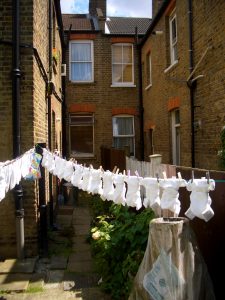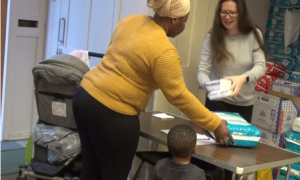The hidden hurdle of nappy need for struggling families
Posted on 21 Feb 2019 under Children's Voices, News, Poverty Premium
Audrey Symes is a volunteer for the US-based National Diaper Bank Network, and is working with a consortium of British charities to publicise the issue of nappy need in the UK.
What is nappy need?
The problem of nappy need across the UK is as critical as it is unrecognised. Due to the expense of nappies and the lack of government subsidy for their purchase, millions of parents cannot afford an adequate supply to maintain proper infant hygiene. Though there is no formal research on this topic in the UK, anecdotal evidence suggests that nappy need is similar in scope to its US equivalent, diaper need, which affects a staggering one in three American families. Currently, parents in need of nappies in both the UK and the US must rely on private, individual donations to food banks and baby banks, which can be inconsistent and difficult to obtain.
Nappy need and the poverty premium
Nappy need is a salient example of the lived experience of the poverty premium for vulnerable families in the UK. Nappies represent a significant cost of early childhood for all families, but those with more resources are able to research internet deals on nappies, buy them in bulk or through a subscription service, and store them, reducing per-unit cost. Families in need often lack the storage space, internet access and upfront capital to achieve these savings, which means that nappies are actually more expensive per unit for poorer families. Cloth nappies, another potential way of cutting nappy costs, are also an unrealistic avenue for the majority of poorer families; not only do cloth nappies also require upfront investment, many poorer families lack access to a washing machine.
Many families don’t have access to a washing machine.
Photo: Flickr.The child benefit can be used for nappy purchase. However, the high cost of nappies – roughly £13-£32 per month, assuming an average use rate (no illness), and not including wipes or creams – constitutes between 16 and 39 percent of the child benefit for one child. Due to diminishing benefits for subsequent children, having two children in nappies consumes between 19 and 46 percent of the two-child benefit.
Looking ahead: need expected to grow
As the British economy continues to soften, the small charities and baby banks upon which thousands of families depend for nappy supplementation face budget cuts and difficult decisions. A wide range of these charities report that nappies are their primary or one of their primary client requests, particularly from clients that are already facing challenges such as maternal depression, special educational needs and disability (SEND), and asylum-seeking. Additionally, nappies are always in demand from families undergoing the six-week wait for Universal Credit.
Service user collecting donations from the Magpie Project’s baby bank in Newham.
Photo: ITV News.The urgent and critical nature of nappy need, and the danger in which it places vulnerable families, is heartbreakingly captured by an anecdote from Jane Williams, founder of the Magpie Project, which supports mothers and children under five in temporary housing in Newham. Ms Williams reports that mothers seeking asylum came in to the Magpie Project reporting that their Home Office vouchers did not include shops that stocked nappies. These mothers were forced to overuse or reuse nappies or not leave their homes with their babies. The Magpie Project started a fortnightly nappy distribution program, but at a cost of £1,000 per month, wondered if it was truly necessary. After a hiccup in their distribution system that left them without nappies for three weeks, Ms Williams was faced with a client whose 11 month old had such severe nappy rash that she had to be hospitalised. She never wondered about the need for nappy distribution again.
What can I do to help?
An increase in awareness among the public would go far in ameliorating nappy need and helping baby banks serve their clients. So many parents end up with leftover nappies after toilet training, a growth spurt or simply a misplaced order, and these nappies can make a major difference for families in the shadow of the poverty premium. Simply knowing where to take their leftover nappies – and knowing what a massive difference their donations can make – is the first step in fighting this public health crisis and lightening the burden of provision that baby banks face. Social media can be very effective in spreading the word about nappy need and how to donate nappies. Any parent will recognise the importance of this issue, and this recognition will spur donation and increased distribution capacity.
In addition to private donations from individuals, corporate donations of nappies such as through In Kind Direct could potentially be effective and efficient, as they would be easier to catalog and ship than individual donations. However, many baby and food banks have limited storage space and may not be able to handle a large influx of nappies.
As public awareness increases, stories of nappy drives and nappy donations in communities across the UK can be brought to MPs, and seeing constituent activity and advocacy around nappy need could spur government supplementation. This approach has worked in the US; testimony on the outpouring of support for diaper donations in New York City catalysed the passage of a New York City Council bill providing supplemental funding for diapers at homeless and domestic violence shelters across the city.
Where can I donate nappies?
- Stripey Stork has collated a list of baby banks across the UK. They also accept donations in Surrey.
- Nappies can also be dropped off at any Trussell Trust food bank across the UK.
- In London, the Magpie Project featured in this article actively courts donations, as does Lloyd Park Children’s Charity and the Small Project.
- Little Village has locations in Camden, Wandsworth and Southwark all of which are looking for nappies and other baby Equipment.
Audrey Symes
This is a guest blog. The views of the author do not necessarily represent those of the APPG on Poverty.







Comments